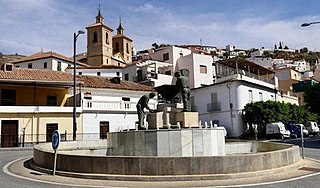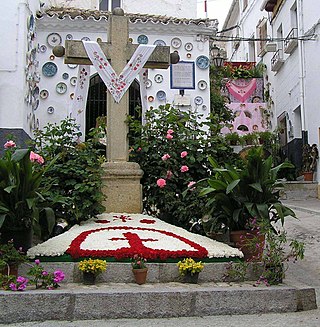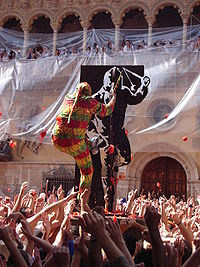La Tomatina is a Spanish festival in Buñol, Spain where participants throw tomatoes at each other. It is said to be the biggest food fight in the world. From the festival's origin as a food fight between friends in the 1940s, it has become a famous tourist attraction. Until 2013 there was no limit to the number of participants; in 2013 the festival became a ticketed event for no more than 20,000, so as not to overwhelm Buñol's population of about 9,000 people.
The festival of San Fermín is a week-long, traditional celebration held annually in the city of Pamplona, Navarre, Spain. The celebrations start at noon on 6 July and continue until midnight on 14 July. A firework (chupinazo) starts the celebrations and the popular song Pobre de mí is sung at the end.

Fermin was a legendary holy man and martyr, traditionally venerated as the co-patron saint of Navarre, Spain. His death may be associated with either the Decian persecution (250) or Diocletianic Persecution (303).

Macabebe, officially the Municipality of Macabebe, is a 1st class municipality in the province of Pampanga, Philippines. According to the 2020 census, it has a population of 78,151 people.

Nochistlán is a city in the Mexican state of Zacatecas. Nuño Beltrán de Guzmán, on December 3, 1531, hired Cristóbal de Oñate to establish a village in Nochistlán; the village would be named Guadalajara to honor Guzmán for having been born in Guadalajara. Guadalajara was founded in Nochistlán on January 5, 1532. Its first officials were Cristóbal de Oñate, Sancho Ortiz de Zúñiga, Juan de Albornoz and Miguel de Ibarra. They worked at this project for only 16 months and created the first layout of Guadalajara.

Apastepeque is a municipality in the San Vicente Department, El Salvador. It is located approximately 50 km east of San Salvador and approximately 6 km from San Vicente. The town has approximately 10,000 residents with 19,895 in municipality.

Isidore the Laborer, also known as Isidore the Farmer, was a Spanish farmworker known for his piety toward the poor and animals. He is the Catholic patron saint of farmers, and of Madrid; El Gobernador, Jalisco; La Ceiba, Honduras; and of Tocoa, Honduras. His feast day is celebrated on 15 May.

The Haro Wine Festival is a summer festival in the town of Haro, La Rioja, Spain. It features a Batalla de Vino and youth bullfights. It is considered a “Festival of International Tourist Interest” and, therefore, is very tourist friendly. The festival takes place on June 29, the day of the patron saint San Pedro.

Albuñol is a town in the province of Granada, Spain. Located a few miles inland, it is regarded as one of the gateways to the Alpujarras mountains. The municipality includes the small beach resort of La Rabita.

Fuente Álamo de Murcia is a town and municipality in the Region of Murcia, southern Spain. It is situated 22 km northwest of Cartagena and 35 km south west of Murcia. The town lies in the basin of the Mar Menor surrounded by the mountains of Algarrobo, Los Gómez, Los Victorias and the Carrascoy.

Cuquío is a town and municipality, in Jalisco in central-western Mexico. The municipality covers an area of 248 square miles (643 km2). It limits to the North with the municipality of Yahualica and the State of Zacatecas; to the South, Zapotlanejo and Acatic; to the East, Yahualica and Tepatitlán; and to the West, Ixtlahuacán del Río. Its name derives from the word Cuixui, which in the Aztec language Náhuatl means kite, and is interpreted as "place of kites", or in Tarascan language, "place of frogs or toads". The foundation of the town is awarded to the Purépechas (Tarascans) who repeatedly ventured through these valleys after the Saltpeter War (1480-1510). As a third version about the origins of the municipality name, it is well known that the tribe of coquias settled in La Cofradía, two kilometers from the current town, whose name is conjectured the denomination comes from. Cuquío also depended on the Tonalteca kingdom.

The Fiesta de las Cruces or Cruz de Mayo is a holiday celebrated on 3 May in many parts of Spain and Hispanic America.

The Carnival of La Bañeza, in the province of Leon, is a festival declared of national tourist interest that began to gain importance and fame at the beginning of the 20th century during the repression under Franco, due to the prohibition of concealing one's face or wearing a costume. The main characteristic of La Bañeza's carnival is the absence of a costume competition with prizes and monetary compensation for participating, which may occur in carnivals elsewhere. Most of the city dedicates themselves wholeheartedly to the festival, passing on interest through generations. In many cases, participants prepare a year in advance, searching for accessories, fabrics, masks and acts they will perform, motivated by a "carnival feeling", lived during those days. Given this, the disorganized carnival is becoming increasingly popular, dressing up outside of parade hours, or on days without events, in the workplace, etc. looking to surprise and amaze the citizens and visitors.
The category of Fiesta of National Tourist Interest in Spain is an honorary designation given by the General Secretariat of Tourism of the Ministry of Industry, Trade and Tourism of the Government of Spain to fiestas, festivals or events held in Spain that offer real interest as national tourism attractions. This category was created in 1979 to adjust the new competences of the ministries in the transition. Since 1965, and until 1979, there was only the declaration of Fiesta of Tourist Interest, and with the new reform the honorary designations were divided into three tiers: Festivals of International Tourist Interest, Festivals of National Tourist Interest and Festivals of Tourist Interest.
Numerous events and festivals are held annually in Metro Manila. They include:

The Fiestas de la Virgen Blanca have been celebrated every year, since 1884. It is held on 5 August, but the celebrations begin the day before, on the 4th, and end on 9 August. It honours the patron saint of the city, and features a programme of special events, activities and free open-air concerts.
The Magdalena Festival is the main festivity of Castellón de la Plana, the capital city of the province of Castelló, in the Valencian Community, Spain. It commemorates the origins of the city, recalling the move of the city from the Hill of Mary Magdalene to the fertile coastal plain in 1251.

The Ruta del Tambor y el Bombo is a celebration of Easter and the Passion of Christ that takes place in nine towns in south-eastern Aragon (Spain), in the province of Teruel: Albalate del Arzobispo, Alcañiz, Alcorisa, Andorra, Calanda, Híjar, la Puebla de Híjar, Samper de Calanda and Urrea de Gaén. During the Holy Week, a number of residents of those towns wear a special tunic and play either the drum or the bass drum at specified moments, also marching during processions. The combination of all the drums playing simultaneously creates a remarkably loud din.

Fiestas patronales de Ponce is an annual cultural celebration held at Plaza Las Delicias in Ponce, Puerto Rico. The celebration, which commonly lasts three days, takes place in late December. Ponce's Fiestas patronales are heavily influenced by Spanish culture and religion, and are a tradition held in honor of the city's patron saint, the Virgen of Guadalupe. As such the celebration may be as old as the town itself (1692). The festivities usually include religious processions honoring its Catholic heritage. However, elements of African and local culture have been incorporated as well. They also feature parades, games, artisans, amusement rides, regional food, and live entertainment. It is attended mostly by people from the city of Ponce and its 18 surrounding barrios, but also people from all over Puerto Rico. The free event's attendance is estimated in the hundreds every day.














